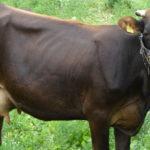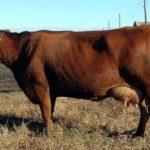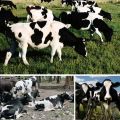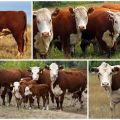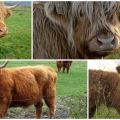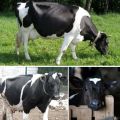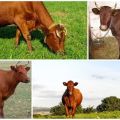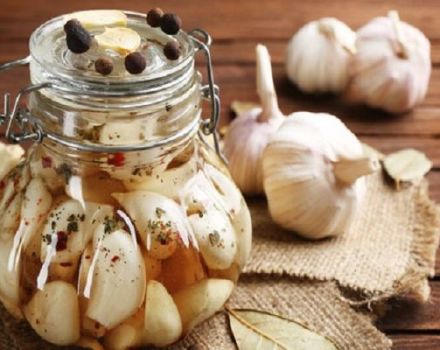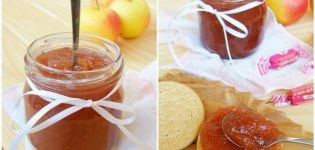Description and characteristics of Angler cows, maintenance rules
Angler cows and bulls are highly valued by farmers for the quality of the produce. The Angler breed shows good meat performance. Milk is in demand among cheese producers due to the high protein content in milk and the presence of carra-casein. Bulls are carriers of this gene, which ensures good quality cheeses.
History
Mentions of a breed of cows called Angelnaya can be found in documents dating back to the 16th century. Angeln is a German peninsula that served as a place for breeding work. As a result of selection, by improving the brown-red and shorthorn breeds, the Angler cow was bred.
Only in the 19th century did the Angler breed gain recognition from Russian livestock breeders. Pedigree cattle were actively used to breed various “red” breeds: steppe, Polish, brown Latvian, Belarusian.
External data and characteristics of Angler cows
Representatives of the breed are distinguished by an exterior characteristic of dairy cows (narrow body, thin skin, underdeveloped skeleton). Features of the constitution of Angler cattle:
- massive elongated body (at the withers the animal grows up to 1.3-1.45 m) with well-defined ribs (thanks to thin skin), wide sternum, flat back;
- the head is medium in size, the horns grow forward. On a long neck, the skin gathers in a peculiar way;
- limbs are not long, with well-defined joints;
- a bowl-shaped udder with extended teats, which is convenient for milking (both manual and machine).
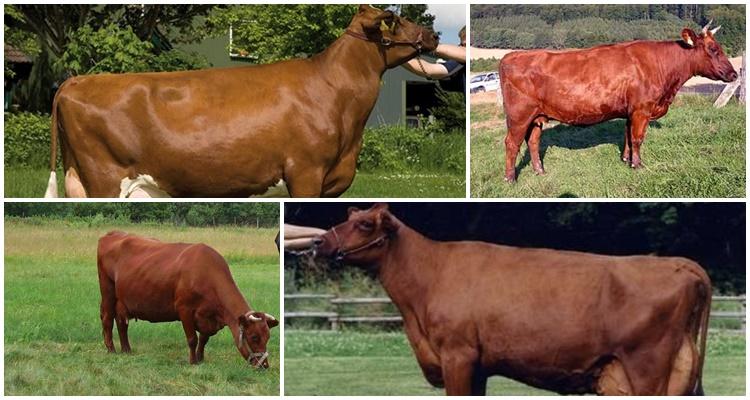
A distinctive feature is a uniform red color (cows with white marks on the udder and the tip of the tail come across). Adult cows gain weight 520-550 kg (the weight of bulls is 2-2.5 times more). After slaughter, the meat yield is 50-55%. Calves are born weighing 30-36 kg. The annual milk yield of a cow is 5000-7500 liters of milk with a fat content of up to 5%.
Breed advantages and disadvantages
Angler cows have the main advantage - high milk yield, which has a delicate aftertaste with light sweetish notes. Shows breed and other merits:
- undemanding to the conditions of detention;
- omnivorous (it's easy to make a varied diet);
- high food value of milk (4.58% fat, 3.6-5% protein);
- meat is juicy, tender due to thin layers of fat;
- cows of a calm disposition, non-conflicting with other pets;
- individuals of the Angler breed have excellent health, resistance to viruses and diseases.
There are no clearly expressed disadvantages in cattle.Farmers note the wayward nature of individual individuals, but it's easy to get used to such features.
What do you need to know about housing and feeding?
Angler cows are unpretentious in keeping and are quite hardy. For full development, it is necessary to provide the cattle with cleanliness in the barn, regular walking. To prevent infection with infections, animals are regularly vaccinated.
Cows are picky about their diet, but good nutrition is needed to get nutritious milk.
Feeding during warm and cold seasons is nuanced. In summer, animals feed mainly on pastures with fresh grass, and receive complementary foods in the form of 500-600 g of bran, 550-650 g of meal. Hay and silage form the basis of the winter diet. Example of daily winter feeding per cow:
- vegetables (potatoes, beets) - 4.5-5 kg;
- bran and cake - 1.5-2 kg each;
- silo - 28-32 kg;
- hay - 5.5-8 kg.

The food is distributed in several doses. Moreover, in the morning it is recommended to feed roughage, and in the evening - the rest. It is desirable to carry out feeding at certain hours. The transition from a summer diet to a winter diet should be smooth. Alternatively, hay is added to the freshly cut grass, gradually increasing its portion. Animals should have access to fresh water at any time of the day, since a cow can drink 65-70 liters of water per day.
Breeding features
Angler breed heifers are actively growing and can produce offspring from the age of 18-24 months. Calving takes place once a year. One cow calves 15-18 times during her life (but after 14 calving, the animal is considered old).
Newborn calves stand on their feet without assistance and can independently feed on their mother's milk. A calf drinks 7-8 liters of milk per day. Gradually, complementary foods are introduced into the diet of animals, starting from the age of two months. One-year-old calves are transferred to a common herd.

Disease resistance
Farmers note the resistance of Angler cows to viruses and diseases. However, there are isolated cases among animals:
- leukemia;
- tuberculosis;
- brucellosis.
Infections are rare. Since diseases pose a danger to humans, all livestock must be vaccinated. Already a week old calf is given the first vaccination. In order not to miss a vaccination, it is recommended to have a vaccination calendar.
Cows are susceptible to togovirus infection (viral diarrhea). The disease is not well understood, and there is no reliable information about the modes of transmission. The incubation period can last for 1-1.5 years, the mortality rate is 10% of the livestock. Animals 2-24 months old get sick. Diagnosis is clinical. Preventive measures - isolation of sick individuals, daily disinfection of premises.
Due to its excellent production qualities and excellent health, Angler cattle are in demand among farmers. Resistance to infections makes the breed more attractive to breeders. For breeding and keeping cattle, no special conditions are required.


